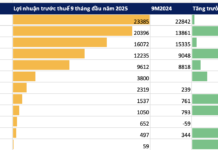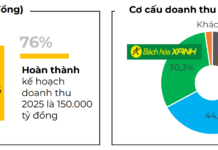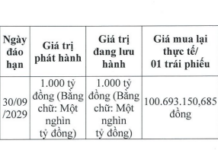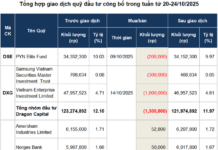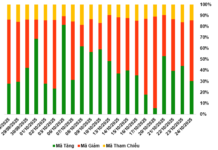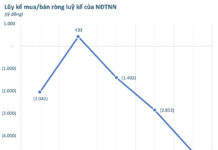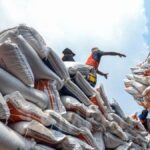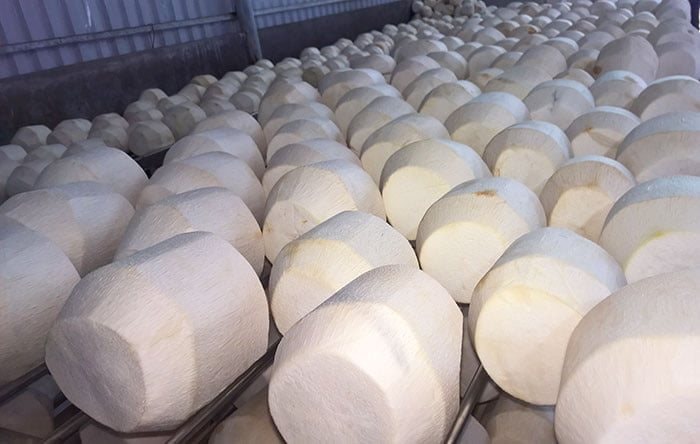
The billion-dollar fruit in question is none other than the coconut. This versatile fruit is one of Vietnam’s most valuable exports, generating over $1 billion in revenue.
This information was shared at the forum, “Connect Production and Consumption of Coconut Products” in Ben Tre province on December 13th. The event was organized by the Vietnam Agricultural Newspaper in collaboration with the Department of Quality Management, Processing and Market Development, and the Department of Science, Technology, and Environment, along with other relevant agencies.
According to Ms. Nguyen Thi Thanh Thuy, Head of the Department of Science, Technology, and Environment under the Ministry of Agriculture and Rural Development, coconut is one of the six key industrial crops in Vietnam, as outlined in the Development Plan for Key Industrial Crops until 2030 (including coffee, rubber, tea, cashew, pepper, and coconut).
In reality, Vietnamese coconuts are becoming a high-value export commodity. As a result, coconut-derived products not only have the potential to increase the value of coconuts but also to boost the income of farmers.
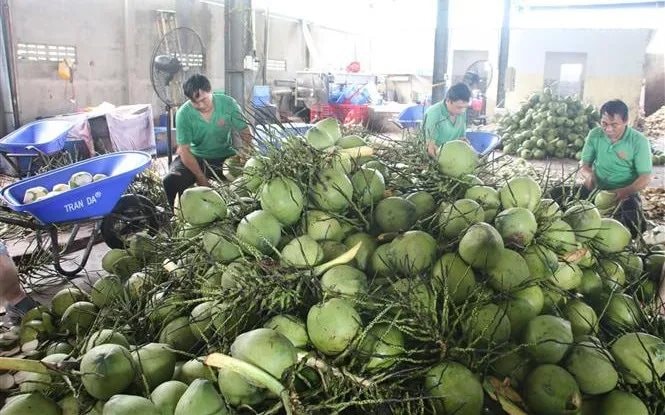
Vietnam’s coconut export turnover is expected to surpass the $1 billion mark in 2024. Illustrative image.
Previously, according to statistics from the General Department of Customs, in 2023, the total export value of Vietnam’s coconut industry reached $900 million, setting a historical record. In 2024, coconut export turnover is expected to surpass the $1 billion mark.
At the forum, Mr. Huynh Quang Duc, Vice Director of the Ben Tre Department of Agriculture and Rural Development, shared that every year, coconut exports bring in more than $350 million to the province.
According to Mr. Huynh Quang Duc, with an area of over 88,000 hectares, accounting for 88% of the coconut area in the Mekong Delta and nearly 42% of the country’s coconut area, coconuts are considered a key crop in Ben Tre. This tree provides income for more than 200,000 rural households in the province.
Moreover, Ben Tre’s green coconut products have been granted a trademark registration certificate and a national geographical indication certificate.
Up to now, Ben Tre province has 133 coconut-growing regions with 133 codes and an area of over 8,300 hectares. In addition, a chain link has been established in the Ben Tre coconut industry, with the participation of eight large enterprises with modern processing technology. This has helped bring the province’s organic coconut products to major markets such as the US, EU, Japan, and China…
What is the biggest challenge for Vietnam’s “billion-dollar” commodity?
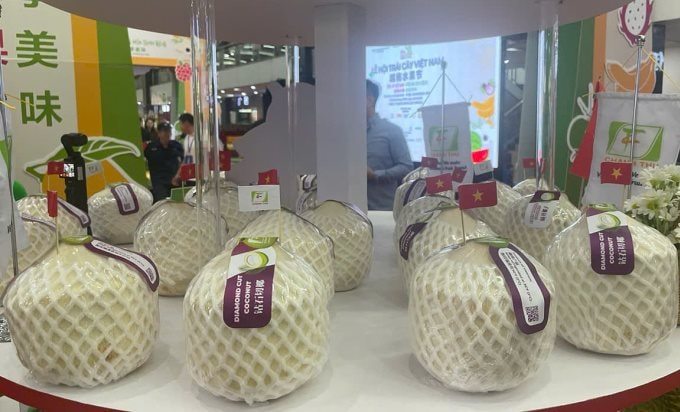
Vietnamese coconuts on display at a fair in China in late September 2024. Photo: DK
Despite the potential for expanding coconut export markets, according to Ms. Nguyen Thi Kim Thanh, Chairwoman of the Vietnam Coconut Association, Vietnam’s coconut processing industry is facing a serious shortage of raw materials.
The Chairwoman of the Vietnam Coconut Association pointed out that while enterprises have invested in facilities and factories in Ben Tre, the province’s raw material supply is insufficient to meet the demand of all factories. As a result, many enterprises have had to cease operations or operate at a minimal capacity of 10-15%.
On the other hand, in recent years, due to the zero percent tax rate on dried coconut, many enterprises have established bases for processing dried coconut and exporting it to China for further processing. Consequently, the supply of dried coconut raw materials for domestic production is facing a significant threat.
To protect domestic raw materials and attract investment in deep processing, Ms. Nguyen Thi Kim Thanh cited the example of Indonesia. Specifically, starting January 1, 2025, Indonesia, the current leading exporter of dried coconut, will impose an 80% export tax on coconuts.
According to the representative of the Vietnam Coconut Association, if there is no early tax policy and trade barrier to retain the coconut raw material source for the processing industry in our country, our coconut industry will decline.
Furthermore, to address the issue of buying and selling region codes and packaging facilities in the coconut and agricultural product industry, according to Mr. Nguyen Phong Phu, Technical Director of Vina T&T Group, it is necessary to build a digital system to manage region codes and packaging facilities strictly, from production to export. At the same time, competent authorities need to strictly handle fraudulent acts and strengthen training to raise awareness among farmers and enterprises about their responsibility to protect the national brand.
Only when monitoring and management measures are implemented synchronously can the coconut export sector effectively tap into the potential of large markets like China, ensuring its competitive position and sustainable development in the future.
The Age of Ascension: Unleashing a New Cycle of Growth, Overcoming the Greatest Obstacles.
“The era of advancement is upon us, and it’s time to address multifaceted issues with determination and action. We must chart a course for each challenge, engaging all stakeholders in a collaborative process of discussion and implementation to ensure success.” – Professor Nguyen Duc Khuong, Chairman of the AVSE Global Scientific and Experts Organization.
The Unstable Price of ‘White Gold’: A Story of Struggling Divers
Vietnam has been recognized for its potential to excel in the salt industry. However, the predominant manual production methods and the dispersed nature of small-scale salt farmers have resulted in low salt yield and quality. To break free from poverty, it is imperative to focus on multiple crucial objectives outlined in the plan for the development of the salt industry by 2030.









